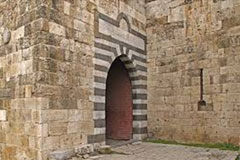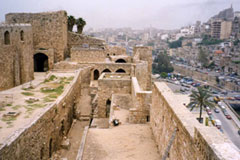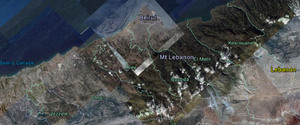Saint Gilles Citadel Tripoli
Tripoli in history –time line
1400–1200 BCE: Recent discovery of pottery fragments: evidence of late Bronze Age settlement. Historical written records mention the settlement of the Had'teen Tribe (Cana'anian) after migrating from Palestine (13th BCE); later on they were known as Tripolitans. Greeks named the Cana'anians 'the Phoenicians.'
14th–8th century BCE: Phoenician trading station. Later on, Phoenicians started sailing to shores of Northern Africa and South Europe and establishing cities in many Mediterranean localities.
550–351 BCE: Phoenicia became a province of the Persian Empire.
351 BCE: Full independence proclaimed by Phoenician states from the Persian Empire.
358 BCE: Triple city coalesced into one entity; became the center of Phoenician confederation and neutral meeting ground for the governors of the three main Phoenician cities/seaports: Aradus (modern Ruad in Syria), Sidon, and Tyre.
333 BCE: Alexander the Great in Phoenicia following victory over Persian king at Issus, arsenals of Tripolis harbor burned down.
323 BCE: Alexander's death and break-up of his empire into three parts: Macedon, Egypt (ruled by the Ptolemies), and the Seleucid Empire. Struggle between the Ptolemies of Egypt and the Seleucid kings of Antioch; Tripolis passed back and forth between the two powers.
64 BCE: Phoenicia and the rest of Syria became a Roman province; Tripoli, Tyre and Sidon granted privileges of self-government (secondary role of Tripolis compared to Beirut and Sidon); Roman general Pompey beheaded Dionysius, the ruler of Tripolis, judged as tyrant.
37–36 BCE: Tripolis is a part of the donations by Marc Antony to Cleopatra.
117–138 CE: Under Emperor Hadrian, Tripolis was granted the right of asylum and assigned a naval command; it became an important religious center with a temple for imperial cult; from numismatic evidence it must have had temples dedicated to Astarte, the Dioscuri and Zeus Haghios.
551: City destroyed by earthquake and tsunami and rebuilt with the help of Byzantine Emperor Justinian I.
645/646: Muslim army laid siege to Tripoli. General Sufyan built a fort on Abu Samra hilltop to survey the city; population fled to Cyprus; Tripoli captured and resettled with Persians and Jewish population.
646–1070: Tripoli subject to Byzantine incursions during the Umayyad, Abassid and Fatimid rule aimed at the control of the coastal road.
1070–1109: Tripoli politically independent from the Fatimids under the BanuAmmar emirs, who built the famous Dar Al-Ilm (a library that contained around 3,000,000 manuscripts).
1099: Beginning of a ten years siege of Tripoli by Raymond of Saint-Gilles, Count of Toulouse (d. 1105 prior to the ending of the siege).
1103: Beginning of the construction of the Citadel.
1109: Fall of Tripoli to the Crusaders and its rebuilding over Muslim town.
1268: The castle and the Crusaders burg occupied and destroyed by Baibars.
1289: Fall of Crusader Tripoli (harbor city or El Mina) to Sultan al-Mansur Qalawun; city site was transferred afterwards inland to the foot of Mount Peregrinus (Abu Samra) for protection against the return of the knights still on Cyprus and Rhodes; Arab Tripoli or medina built around inland citadel (the castle of saint-Gilles) over Crusader bourg and along the banks of Qadisha River (Abu Ali).
1516: Syria and Egypt fell to the Ottoman Sultan Selim I.
1535: Signature of treaty by Suleiman the Magnificent and François I, King of France, giving France favors and privileges in the Levant.
1612: Flood destroyed Mamluk monuments.
1623: Fakhr-ed-Din attacked the forces of Pasha of Tripoli at Anjar; Tripoli fell to Fakhr-ed-Din, (Sultan al-Barr or Sultan of the Land).
1798–1835: Mustafa Agha Barbar ruled as governor of Tripoli on behalf of the Ottoman Empire.
The County of Tripoli
The County of Tripoli (1109 – 1289) was the last of the Crusader states. It was founded in the Levant, that is, the modern day region of Tripoli, northern Lebanon and parts of western Syria which supported an indigenous population of Christians, Druses and Muslims.

When the Crusaders, (Christian, mostly Frankish forces), captured the region in 1109, Bertrand of Toulouse became the first Count of Tripoli. He was a vassal of Baldwin I of Jerusalem. From that time, rule of the county was decided not strictly by inheritance but by factors such as military force ,favour and negotiation. In 1289, the County of Tripoli fell to Sultan Qalawun of the Muslim Mamluks of Cairo. The county was absorbed into the Islamic Empire.
The citadel
The Citadel of Raymond de Saint-Gilles, also known as Qala'atSanjil in Arabic, is a citadel and fort in Tripoli, Lebanon. It takes its name from Raymond de Saint-Gilles, the Count of Toulouse and Crusader commander who started its construction on a hilltop outside Tripoli in 1103 in order to lay siege to the city. Later, Raymond enlarged the fortress, which he named Mont Peregrinus (a natural ridge, which he named "Mons Peregrinus" 3 kilometres (1.9 mi) from Tripoli)
Another theory considers that the citadel was founded by Arab commander Syfan bin MajidaLAzdi in thr 10-11th centuryAD, later in the 11st century the Fatimids constructed a mosque inside the fortresses,
 |  |  |
Raymond de Saint Gilles enlarged the citadel in the 12th century,.
When Mamlouk prince Kourji ruled Tripoli from 1299 to 1309 prosperous constructions were added to the castle.













